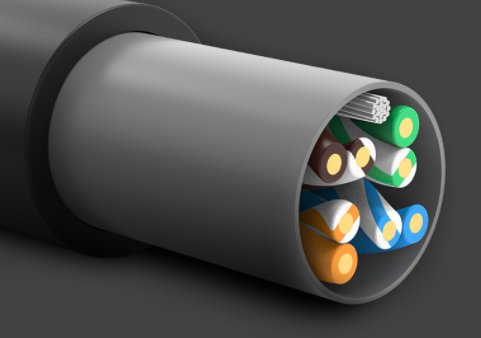Do you know the six materials of the network cable?
The commonly used network cables are generally super five or six types of cables. Although they are all network cables, there are also several types of network cables. Let's take a look at the six materials of network cables today. Four iron four aluminum network cable Four iron and four aluminum is the worst quality network cable among them, the transmission quality is poor, and it is easy to appear attenuation. A 100-meter resistor is about 50 ohms and can transmit up to 60 meters. The differences are as follows: A. For the aluminum mesh cable, the inner layer has no luster and will break when pulled; B. The simplest method is this. Use a magnet to attract the network cable. If it is attracted, it proves that the network cable contains iron; C. The four cores of iron and aluminum are of different materials, which are much harder than all copper and copper-clad aluminum materials; D. Burned with fire, the hardness of iron is very high. Burned with fire will not soften quickly. 2. Copper clad aluminum network cable The material of the copper-clad network cable is covered with a layer of oxygen-free copper on the copper core marked with aluminum or aluminum / steel alloy core. Because aluminum is less conductive than copper, the DC resistance of copper-clad aluminum conductors is greater than that of pure copper conductors. If used for power, copper-clad aluminum conductors will cause additional power consumption and lower voltages. The resistance of 100 meters is about 28 ohms. If you compile it and buy it, it can transmit about 100 meters, with poor oxidation resistance and short service life. The tensile strength of copper-clad aluminum is not as great as that of copper conductors, that is, the tensile strength is low. Do not pull the cable body vigorously during use. 3. Oxygen-free copper network cable We can see from the copper core of the wire, in general, all copper network cable is the new material of the outer layer, and oxygen-free copper is the new material of the inside and outside. You can check the gloss of the thread and cut it to see if it can be thinned. The newer gloss is the new material, and the thinner is the new material. However, the current all-copper network cable also tends to be new inside and outside, so it can only be used as a basic basis. If you use a knife to scrape the surface or cross section: Oxygen-free copper network cable: scrape off the surface layer, the color is basically the same, and the cross-section color is uniform, no difference; Bronze wire: Scratching indicates a layer, the surface and internal colors are different, and the cross section is a little white. If you burn it with fire, the surface of the whole copper is coated with a layer of oxygen-free copper. During the burning process, you will find that the outer layer of oxygen-free copper will melt, and then wipe it with paper. It will be difficult to change the copper core back to the original yellow. copper; Oxygen-free copper contains no impurities. During the burning process, only the surface is oxidized. After wiping with paper, it will still return to its original yellow color. According to the standards, the oxygen content in oxygen-free copper network cables is not more than 0.003%, the total content of magazines is not more than 0.05%, and the purity is greater than 99.95%. Therefore, oxygen-free copper has high conductivity, processability and welding performance, corrosion resistance and low temperature. Good performance, suitable for high quality network cable material. The resistance of oxygen-free copper network cable is less than 10 ohms within 100 meters, and can transmit about 120-150 meters. The signal transmission distance is long and the packet loss rate is low. Copper, network stability is guaranteed, strong oxidation resistance, long life. 4. High-conductivity copper network cable The high-conductivity copper network cable does not only contain copper-silver components, but is actually a copper-aluminum-silver alloy high-performance network cable. It is also commonly referred to as copper-clad silver. It has the characteristics of low resistance and long transmission distance. Compared with all copper and iron-aluminum network cables, the resistance is about 20 ohms for 100 meters and can transmit 120 meters, but the oxidation resistance is poor and the life is not long. 5. Copper-clad copper network cable The copper-clad copper network cable refers to a layer of oxygen-free copper plated on the outside of the bronze, so it is also called a bronze network cable. This kind of network cable is generally ignored by everyone, and not many people understand it. The conductor of the bronze network cable belongs to secondary furnace copper and contains more impurities. The resistance of 100 meters is about 40Ω, and it can transmit about 80 meters. It has strong oxidation resistance and long service life. The resistance of bronze is much higher than that of ordinary c
2023-02-16








